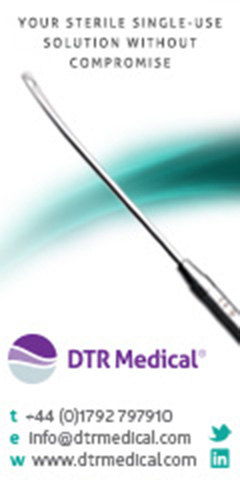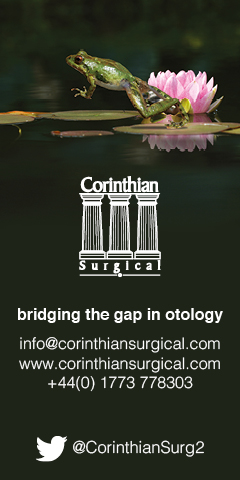Sphenopalatine Artery Ligation
Surgery - Richard Douglas, New Zealand
Capture and Editing - Martyn Barnes, United Kingdom
Editing, Illustration, Script and Narration - Pavol Surda, United Kingdom
Surgery - Richard Douglas, New Zealand
Capture and Editing - Martyn Barnes, United Kingdom
Editing, Illustration, Script and Narration - Pavol Surda, United Kingdom
VIDEO RELEASED PENDING PEER REVIEW
An instructional video on the surgical technique of a sphenopalatine artery ligation. This technique is increasingly considered to be an essential component of training for any otolaryngologist and can greatly reduce periods of nasal packing and active bleeding for your patients and length of stay for your hospitals.
It is also an essential skill for any surgeon performing surgery in the nose.
It is also an essential skill for any surgeon performing surgery in the nose.
1. Foramen Location
The sphenopalatine foramen is located in the nasal side wall, lateral (not inferior) to the posterior end of the middle turbinate.
2. Peer Review is pending
None so far...
The sphenopalatine foramen is located in the nasal side wall, lateral (not inferior) to the posterior end of the middle turbinate.
2. Peer Review is pending
None so far...
1. Division vs. Non-division
Even within the authors, there is disagreement.
The arguments for division is that by dividing and visualising beyond the main trunk, all branches will be identified and addressed. MB
The argument against division is that the artery may retract and become lost within the pterygopalatine fossa resulting in much more difficult control. PS
So we need a video on (a very limited) pterygopalatine exploration and/or maxillary artery approach. MB
2. Indications for SPA ligation
Our suggestion is that SPA ligation should be performed in any case where control is not achieved by nasal packing, or bleeding recurs on pack removal. There are exceptions (e.g. post-trauma with suspected anterior ethmoid bleeds).
3. Others? - Peer Review is pending
Even within the authors, there is disagreement.
The arguments for division is that by dividing and visualising beyond the main trunk, all branches will be identified and addressed. MB
The argument against division is that the artery may retract and become lost within the pterygopalatine fossa resulting in much more difficult control. PS
So we need a video on (a very limited) pterygopalatine exploration and/or maxillary artery approach. MB
2. Indications for SPA ligation
Our suggestion is that SPA ligation should be performed in any case where control is not achieved by nasal packing, or bleeding recurs on pack removal. There are exceptions (e.g. post-trauma with suspected anterior ethmoid bleeds).
3. Others? - Peer Review is pending
Welcome to our sphenopalatine artery ligation video.
This procedure is quite commonly performed in epistaxis that originates from the posterior part of the nasal cavity. Here you can see the crucial area of the sphenopalatine artery foramen.
I will explain the anatomical relations of this image. Foramen is located inferiorly to the posterior end of the middle turbinate (incorrect - see corrections). The second anatomical landmark is posterior membranous fontanelle of the maxillary sinus, which can be palpated using curved suction. Foramen is located posteriorly to the fontanelle. The sphenopalatine artery can have up to 10 branches, but we mainly recognize these two - a posterior nasal artery and horizontal branch that goes into middle turbinate. We need to keep in mind that maxillary artery quite commonly divides prior to the foramen and therefore it is important to explore the lateral nasal wall properly. Many patients who arrive to the theatre are actively bleeding, and therefore it is very important to decongest the nose with Moffat’s solution and infiltrate the mucosa with lidocaine and adrenaline. In this patient, we have already performed the antrostomy, and we will use this as a main anatomical landmark. We will not create the typical mucoperichondrial flap as seen on the diagram before, but extent the excision towards the antrostomy. For this, we recommend the sharp sickle knife or keratoma knife.
Once the incision is made, we need to elevate the mucoperichondrial flap, ideally using the Freer’s or suction Freer’s towards the sphenopalatine artery foramen. To avoid unnecessary tear or traction of the artery we first create the inferior tunnel and then push the suction Freer’s upward to the foramen. Once we get closer to the foramen, we should be very cautious as this area is fragile and ruptured artery can cause profuse bleeding. In order to reduce the minimum tearing of the mucosa, sometimes using sharp instruments such as scissors can be very helpful. As we approach the foramen, just anteriorly to it is a very stable anatomical landmark - the ethmoidal crest of the palatine bone. Often we have to lateralize it the crest with suction Freer’s in order to get a nice exposure of the foramen. If the bone is hard, we have to use the Hajek-Koffler punch forceps.
At this point, we should pay extra attention to dissect the lateral wall properly and dissect all the branches of the sphenopalatine artery. We find quite helpful to dissect occasionally with adrenaline-soaked neuropatties, as this reduces the bleeding and also causes less damage to the surrounding tissue.
Here you can see the anatomical relations of the sphenopalatine artery again. Now you can see the cauterization of the artery with bipolar coagulation. Some authors recommend to clip the artery, but it is very difficult as the foramen sits very close to the sphenoid bone, and therefore the metal clip very often dislodges. Generally, we do not recommend a division of the artery as this can result in major bleeding in some cases later on. The Patient is usually discharged the same day if no further bleeding is noted. We often apply surgical locally Surgicel in patients who take warfarin or aspirin. There is no need for packing. Thank you for watching our video. We always emphasize that is our own technique which will almost certainly change with the time. If you feel that you have got any interesting tips or contributions, please get in touch with us through SurgTech.net.
This procedure is quite commonly performed in epistaxis that originates from the posterior part of the nasal cavity. Here you can see the crucial area of the sphenopalatine artery foramen.
I will explain the anatomical relations of this image. Foramen is located inferiorly to the posterior end of the middle turbinate (incorrect - see corrections). The second anatomical landmark is posterior membranous fontanelle of the maxillary sinus, which can be palpated using curved suction. Foramen is located posteriorly to the fontanelle. The sphenopalatine artery can have up to 10 branches, but we mainly recognize these two - a posterior nasal artery and horizontal branch that goes into middle turbinate. We need to keep in mind that maxillary artery quite commonly divides prior to the foramen and therefore it is important to explore the lateral nasal wall properly. Many patients who arrive to the theatre are actively bleeding, and therefore it is very important to decongest the nose with Moffat’s solution and infiltrate the mucosa with lidocaine and adrenaline. In this patient, we have already performed the antrostomy, and we will use this as a main anatomical landmark. We will not create the typical mucoperichondrial flap as seen on the diagram before, but extent the excision towards the antrostomy. For this, we recommend the sharp sickle knife or keratoma knife.
Once the incision is made, we need to elevate the mucoperichondrial flap, ideally using the Freer’s or suction Freer’s towards the sphenopalatine artery foramen. To avoid unnecessary tear or traction of the artery we first create the inferior tunnel and then push the suction Freer’s upward to the foramen. Once we get closer to the foramen, we should be very cautious as this area is fragile and ruptured artery can cause profuse bleeding. In order to reduce the minimum tearing of the mucosa, sometimes using sharp instruments such as scissors can be very helpful. As we approach the foramen, just anteriorly to it is a very stable anatomical landmark - the ethmoidal crest of the palatine bone. Often we have to lateralize it the crest with suction Freer’s in order to get a nice exposure of the foramen. If the bone is hard, we have to use the Hajek-Koffler punch forceps.
At this point, we should pay extra attention to dissect the lateral wall properly and dissect all the branches of the sphenopalatine artery. We find quite helpful to dissect occasionally with adrenaline-soaked neuropatties, as this reduces the bleeding and also causes less damage to the surrounding tissue.
Here you can see the anatomical relations of the sphenopalatine artery again. Now you can see the cauterization of the artery with bipolar coagulation. Some authors recommend to clip the artery, but it is very difficult as the foramen sits very close to the sphenoid bone, and therefore the metal clip very often dislodges. Generally, we do not recommend a division of the artery as this can result in major bleeding in some cases later on. The Patient is usually discharged the same day if no further bleeding is noted. We often apply surgical locally Surgicel in patients who take warfarin or aspirin. There is no need for packing. Thank you for watching our video. We always emphasize that is our own technique which will almost certainly change with the time. If you feel that you have got any interesting tips or contributions, please get in touch with us through SurgTech.net.
Barnes, M L, P M Spielmann, and P S White. "Epistaxis: A Contemporary Evidence Based Approach." Otolaryngol Clin North Am 45, no. 5 (2012): doi:10.1016/j.otc.2012.06.018.
Spielmann, P M, M L Barnes, and P S White. "Controversies in the Specialist Management of Adult Epistaxis: An Evidence-based Review." Clin Otolaryngol 37, no. 5 (2012): doi:10.1111/coa.12024.
If you have references that you think we should add, or any other recommendations for this page, just let us know!
Spielmann, P M, M L Barnes, and P S White. "Controversies in the Specialist Management of Adult Epistaxis: An Evidence-based Review." Clin Otolaryngol 37, no. 5 (2012): doi:10.1111/coa.12024.
If you have references that you think we should add, or any other recommendations for this page, just let us know!
Thanks to our
peer reviewers
peer reviewers
Kim Ah-See
Martyn Barnes
Jochen Bretschneider
Mike Davison
Prof. Richard Douglas
Prof. Wytske Fokkens
Quentin Gardiner
Iain Hathorn
Claire Hopkins
Christopher McCann
Gerald McGarry
Dirk Jan Menger
Mohammed Miah
Salil Nair
Peter Ross
Anshul Sama
Pavol Surda
Nolst Trenité
May Yaneza
Hadé Vuyk
See us on Google+
Martyn Barnes
Jochen Bretschneider
Mike Davison
Prof. Richard Douglas
Prof. Wytske Fokkens
Quentin Gardiner
Iain Hathorn
Claire Hopkins
Christopher McCann
Gerald McGarry
Dirk Jan Menger
Mohammed Miah
Salil Nair
Peter Ross
Anshul Sama
Pavol Surda
Nolst Trenité
May Yaneza
Hadé Vuyk
See us on Google+

